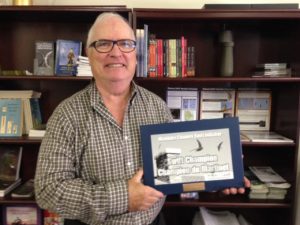 Our latest Swift Champion plaque was presented recently to Lewis Cocks. Many of you will already be familiar with Lewis as a longtime supporter of Chimney Swift conservation in Manitoba. Indeed, Lewis was the closest we have to a founder of MCSI – it was his idea to do something for Chimney Swifts and he was the initial driving force in setting up what we now call the Manitoba Chimney Swift Initiative. Below Lewis answers a few questions about his involvement as a champion of Chimney Swift conservation in Manitoba.
Our latest Swift Champion plaque was presented recently to Lewis Cocks. Many of you will already be familiar with Lewis as a longtime supporter of Chimney Swift conservation in Manitoba. Indeed, Lewis was the closest we have to a founder of MCSI – it was his idea to do something for Chimney Swifts and he was the initial driving force in setting up what we now call the Manitoba Chimney Swift Initiative. Below Lewis answers a few questions about his involvement as a champion of Chimney Swift conservation in Manitoba.1. What were you doing before helping to set up MCSI?
I was able to retire in 2005 but still had an interest in policy, writing, working with others, making a difference and doing something for our feathered friends.
2. You were instrumental in starting MCSI back in 2006. Why Chimney Swifts?
Chimney Swifts populations were in decline, they were urban adapted which meant they were flexible and perhaps amenable to artificial roosting and nesting structures. In essence, if you build something for them, will they come?
3. What were your original intentions for MCSI and how and why did they evolve to where we are now?
Originally our MCSI Steering Cmte was heavily focused on erecting Swift friendly structures, which didn’t attract and retain Swifts so we adapted, we stopped building stand alone structures and switched to repairing existing Swift friendly structures that were falling into disrepair. Interest in our initiative grew along with the need to better understand the breeding biology of Swifts.
4. Who else was involved in those early days?
The granting agencies all wanted to know who would be involved in any proposed activity and it was felt that the original project submission should be a blend of public and private interests. As such, Dr Jim Duncan from Manitoba Conservation, Ron Bazin from the Canadian Wildlife Service of Environment Canada, Cheryl Hemming from the City of Winnipeg Naturalist Services Branch were consulted and were integral and essential early contributors and since I was a Board Member of the Manitoba Naturalists Society ( Nature Manitoba ) we had a great cross section of quite knowledgeable and keen people. Soon after grants from the Federal and Provincial Governments came through we recruited our first of several MCSI Project Coordinators Mike Quigley who was provided office space and support in the City of Winnipeg Naturalist Services Branch Office.
5. What have you learnt about Chimney Swifts since beginning MCSI?
Chimney Swifts are amazing. They come here from the Amazon to raise their young on insects that they hover up from the air above us, within a very tight time frame, find suitable nesting sites, raise young under very demanding circumstances where the weather can be hot, cold, wet and dry and when insects can be super abundant or practically non existent.
6. What are your hopes for the future for Chimney Swifts in Manitoba?
You have to be optimistic or else why do what we do. It may not be too late, but honestly, the trend is for the CS population to continue to decrease. There’s problems and opportunities here in Manitoba and throughout their home range. In the Amazon there is massive habitat destruction, there’s problems over the great distances they travel north and south including increasingly erratic weather, we’re losing most of our suitable chimneys, there are even recent reports of major declines and shifts in insect populations that are complex and just barely beginning to be understood.
7. Anything to add?
There are many very talented, brilliant and committed people who thinking and doing good things to make sure that Swifts survive and thrive and they deserve our thanks and support.
As does Lewis deserve and thanks for his years contributing to our understa
nding of Chimney Swift conservation here in Manitoba. Thanks Lewis!
— Tim Poole
